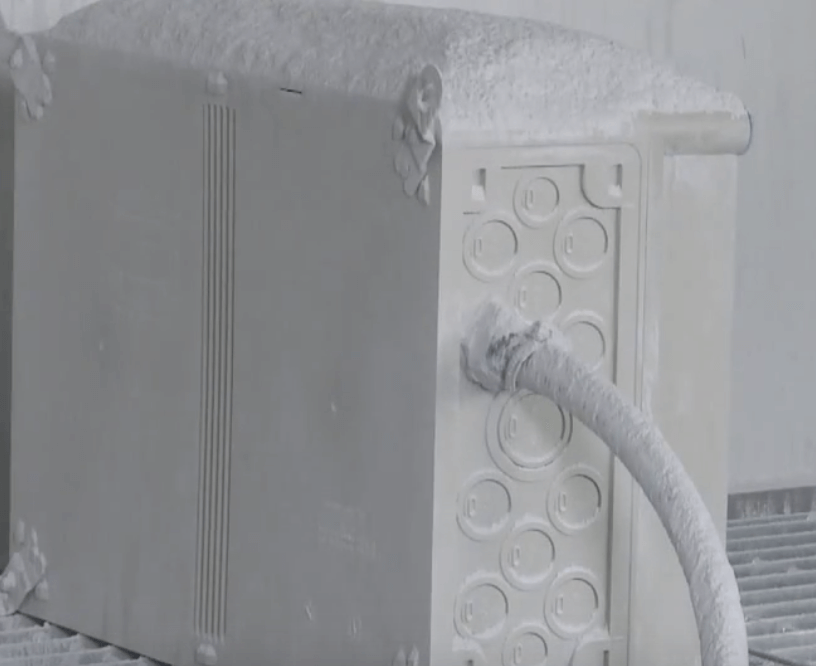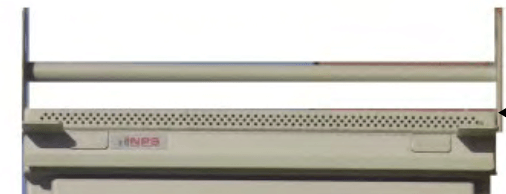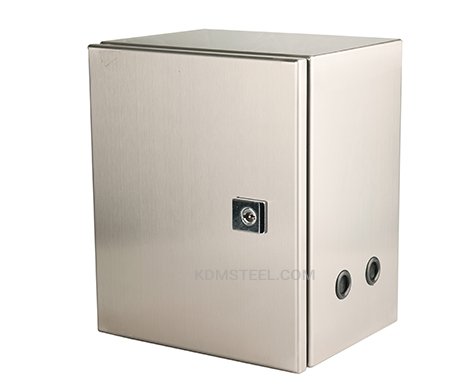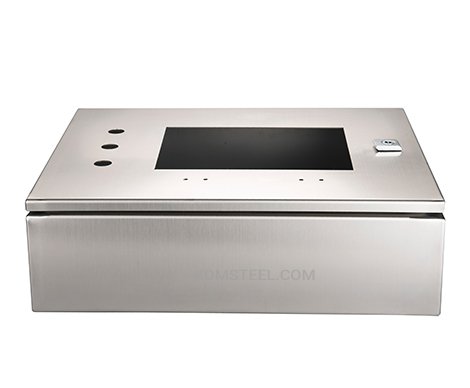- Suitable for both indoor and outdoor use
- IP65/IP66 Certification
- Fast Sample Production within 3 days
Custom IP54 Enclosure Manufacturer in China
KDM IP54 enclosure has a high level of protection against particles such as dirt, dust, oil, and other non-corrosive material. Also protects from voltage and moving parts for people who come in contact with the enclosure. Not just that, IP54 adds protection from splashing of water against the machine from any direction.
All KDM enclosures stringently comply with international standards, so you can count on outstanding and cost-effective IP54 enclosures.
KDM IP54 Enclosure Series
Send your Inquiry on KDM IP54 Enclosure


KDM has a range of installation options, including free-standing, pad-mounted, wall-mounted, pole-mounted, and walk-in.
Engraving, silk-screening, or anodizing services are also offered. Our latest designs and manufacturing processes enable our staff to customize your enclosure efficiently and economically.
- Capacidade de Fabricação

4000W high-performance laser cutting machine, +/- 0.05mm accuracy. No burr, no scratching.

Multi-Functioning flexible welding equipment, high accuracy, no deformation.

+/- 0.5mm bending precision, smooth surface without bending marks.

10+ welding experienced workers, perfect overall appearance.

High speed and accuracy foaming machines, fast and qualified Gasket

The expert assembling team, consistent assembly quality on every KDM enclosure
Recent IP55 Electrical Enclosure Order
KDM IP54 Enclosure

Galvanized IP54 Enclosure

Stainless Steel IP54 Enclosure
KDM manufactured IP54 enclosure to provide top-quality, easily customized cabinets that will perform well in your application.
At KDM, our range of IP54 enclosures features a variety of different materials such as aluminum, carbon steel, and stainless steel.
We also offer a selection of gasket materials, dimensions, and sizes, a variety of colors, flanged options for mounting purposes. Some of our enclosures feature ventilation, display windows, and chassis plates.

If you are looking for a custom enclosure that meets the IP54 standard, our professional designing and development team can help you a lot.
Metal finishes can be customized including aluminum alloys, stainless steel, galvanized steel, and carbon steel, to meet your application requirements.
Finishes available include wet coat and powder coat painting, anodizing, and also dining. You can custom with cutouts, insulation, hinges, latches, or locks.
At KDM, we are dedicated to meeting the cost-savings enclosure you need without compromising quality and the high performance you expect from your IP54 electrical enclosure.
Our careful approach to manufacturing quality and efficiency, combined with creative and innovative designs for custom applications, ensures that your IP54 electrical enclosure will meet your desire for performance, quality, and value.
Our team is capable to manufactured different requirements IP54 enclosure products using high-grade raw material and advanced technology.
KDM provides professional services to each of our customers to gain their confidence and meet their requirements and needs.

Stainless Steel Raw Material
We, at KDM, adhere to providing the best enclosure solution to our client’s problem. In every product we manufactured, we make sure to achieve customer satisfaction.
Our IP54 enclosure is your perfect solution to use whenever application you need it.
With more than 10 years of experience in providing highly reliable enclosures, KDM is your best partner for any of your IP54 enclosure applications.
Our deep expertise in enclosure designing and developing enables our customers to meet the most rigorous application requirements with lower technical and business risk.
Whether you are interested in any of our IP enclosure or if you have an application-specific requirement, contact us!

The Ultimate FAQ Guide to IP54 Enclosures
- What does the IP code mean?
- What does IP54 mean?
- What is the difference between IP45 and IP54?
- What is associated with the letters after the main IP code?
- What testing do IP54 enclosures undergo?
- Can IP54 standards be converted into any NEMA type?
- Can IP54 enclosures be used for outdoor applications?
- Is IP54 waterproof?
- Are IP54 enclosures explosion-proof?
- How well will IP54 enclosures protect electrical components against corrosive agents?
- Where can IP54 enclosures be used and for what applications?
- What designs of IP54 enclosures can I choose from?
- How many doors can an IP54 enclosure have?
- What features can I request for IP54 enclosures?
- What accessories can I request for IP54 enclosures?
- Will additional features compromise the IP rating?
- What types of steel can be used for IP54 enclosures?
- What types of steel can be used for IP54 enclosures?
- Can IP54 enclosures be made of fiberglass?
- Is aluminum better for IP54 enclosures?
- What paints and coatings can be used for IP54 enclosures?
- How do you customize the symbols or writing on an IP54 enclosure?
What does the IP code mean?
The IP code stands for Ingress Protection. It is also known as IEC standard 60529, and EN 60529 in Europe.
It consists of 2 numbers following IP.
The first number corresponds to the level of protection against the ingress of solids, whereas the second digit corresponds to the ingress of liquids.

Dust rating of the IP code
For dust, the numbers go from 1 to 6, and for liquids, they go from 1 to 9K.
Enclosures with a dust rating of 1 would protect against anything that is bigger than 50 mm, or 1.9 in.
On the other hand, enclosures that are fully dust-tight protect against any solid particles.
Enclosures with a liquid rating of 1 are effective against dripping water in an upright position, thus, they are protected against rain.

Liquid rating of the IP code
Meanwhile, 9K enclosures are able to withstand pressurized jets of hot water.
There can be a zero marked, which means no protection.
There can also be an “X” mark, which usually means that any number can be put there.
There can be other lettered markings as well.
What does IP54 mean?
Enclosures rated with IP54 are protected against limited dust ingress, and from water spray from any direction.
Limited dust ingress means that most dust cannot enter the enclosure, but a small quantity of it can.
However, the dust that does get through is not nearly enough to disrupt the work of the electrical components of the enclosure.

IP54 enclosure
What is the difference between IP45 and IP54?
IP45 is more water-proof than IP54, but IP54 is more dust-proof than IP45.
IP45 only protects from wires, not dust. However, it is able to withstand pressurized water.
Meanwhile, IP54 repels most dust, fibers, and lint, but can only protect from normal water spray.
What is associated with the letters after the main IP code?
As mentioned above the “X” means that there is no available information, or that it is irrelevant or replaceable.
There are 2 sets of optional letters you can add after the digits.
The additional set – A, B, C, D – describes the protection of the enclosure against tampering.
A stands for protection against the back of a hand, B stands for protection against a finger, C stands for protection against access with a tool, while D stands for protection against access with a wire.
The supplementary set of letters – H, M, S, W – tell the user what the enclosure is for.
H indicates that the enclosure is made for a high-voltage device, M indicates that the device inside the enclosure was moving during the water test, whereas S indicates that it was standing still.
Finally, W means that the enclosure is weather-proof.

The full IP code
You can use these to indicate what features you want your IP54 enclosures to have.
These are useful for better communication between the client and the manufacturer.
What testing do IP54 enclosures undergo?
Each IP rating has its own testing procedures.
IP5X is tested using a confined space with a vacuum and lots of dust and different powder that is blown all around the enclosure for 8 minutes, and then the enclosure is checked for dust ingress.

Dust chamber testing
IPX4 is tested using spray nozzles with oscillating tubes that pressurize and spray water for 5-10 minutes in any imaginable angle.
Can IP54 standards be converted into any NEMA type?
As for NEMA, we offer any type, starting with 1 and up to 13, including subtypes, such as 3X. Our NEMA enclosures are protected against weather, corrosion, oil seepage, and much more.
IP ratings and NEMA types cannot be directly converted into one another, but they can be loosely compared as shown below.

NEMA and IP rating comparison
As the table shows, there is a close similarity between IP54 and NEMA types 12, 12K, and 13. Types 3 and 5 are also fairly close.
Most of these are for indoor use or outdoor use in non-hazardous locations.
Can IP54 enclosures be used for outdoor applications?
IP54, just like our other IP enclosures, is suitable for outdoor applications because it is protected against low-pressure water sprays from any direction.
However, keep in mind that these enclosures are not entirely dust-tight and waterproof, so very dusty or underwater environments may be too harsh for them.
If you need that, check out our IP65 enclosures.
Additionally, our IP54 enclosures are suitable for mild marine environments due to their ability to withstand pressurized water spray.
Is IP54 waterproof?
Yes, but only under certain conditions.
This enclosure will protect your electrical components only if the water spray is not pressurized.
However, it can be from any direction.
Thus, IP54 enclosures are great for splashing water, rain, and snow.
It may not be waterproof, but it is sufficiently weather-proof.
Are IP54 enclosures explosion-proof?
Unfortunately, IP54 enclosures are not strong enough to contain an explosion or an arc flash.
They are not comparable to NEMA types 7, 8, 9, or 10.
These enclosures need to withstand high impacts and high temperatures.
However, if you need an explosion-proof enclosure, contact us and we will engineer it for you!
How well will IP54 enclosures protect electrical components against corrosive agents?
IP54 is not fully waterproof, so it may not protect against corrosive agents if they are strongly sprayed on it.
If they are just splashed, then there is no problem, but corrosive fumes may still get in because some dust does.
The rest is determined by the material.
Aluminum and stainless steel are the most corrosion-resistant materials.
Where can IP54 enclosures be used and for what applications?
IP54 enclosures can be used both indoors and outdoors in non-hazardous environments.
IP54 enclosures are commonly used in traffic control cabinets, various outdoor metering boxes and control panels, as well as telecom enclosures, and outdoor distribution boards.
This IP rating is perfect for outdoor environments because it is rain-proof and sufficiently protected against dust ingress.
IP54 enclosures are also well protected against tampering, just as any IP5X enclosure is.

IP54 traffic control cabinet
What designs of IP54 enclosures can I choose from?
Designs for IP54 enclosures don’t differ from other enclosures we make.
Namely, we offer free-standing enclosures, floor-mounted, wall-mounted enclosures, pole-mounted enclosures, junction boxes, and custom enclosures.
Free-standing enclosures are perfect for large electrical units that are too heavy to be wall-mounted or pole-mounted.
They could be of any height and width.
They are also portable, and can be walk-in enclosures.

Free-standing enclosure
Floor-mounted enclosures are very similar to free-standing enclosures, only floor-mounted ones are secured to the floor – thus, they are not portable.
Wall-mounted enclosures use mounting brackets, screws, and pads.
They are perfect for small devices, and thus are cost-effective.

Wall-mounted enclosure
Pole-mounted enclosures are not too different from wall-mounted ones.
They also use mounting brackets, but they are ring-shaped, placed around the pole.

Pole-mounted enclosure
Junction boxes and operator interfaces are usually enclosures on a stand.
They have user-friendly layouts, are great for small electrical units, and can be portable.

Junction box enclosure
Of course, we also have our custom enclosures, which can be of any design, shape, and requirement.
How many doors can an IP54 enclosure have?
Single doors are perfect for smaller and less complex electrical units, whereas double doors are used for large and complicated units.
Multiple doors are used for huge industrial applications or for increased security.
If you would like a consultation on our designs, you are welcome to reach out to us!
What features can I request for IP54 enclosures?
You can request vents, windows, hinged doors, locks, cable management systems, and much more.
Vents, as well as radiating fans, provide a path for heat to escape through, cooling electrical components of the enclosure.
This prolongs their life and decreases the possibility of malfunctions.

Radiating fan in an enclosure
These also stabilize air pressure inside the enclosure, preventing condensation which can damage the electrical components of the enclosure.
Plus, the vents can be further upgraded to air conditioners and heat exchangers.
Windows are used to help workers examine the electrical components in a non-invasive way.
And if something goes wrong, a window helps what is happening see right away.
Plus, infra-red windows help protect personnel from arc flash accidents.

Enclosure with a window
Hinged doors control how and how much the door or cover of the enclosure opens.
This also includes a variety of handles that you can request as well.
Locks add a layer of security to your IP54 enclosure, making sure no one tampers with it or accidentally accesses its electrical components.
What accessories can I request for IP54 enclosures?
File pockets are used to store files like operating manuals, shift logs, information booklets, and anything else important that pertains to electrical components within the enclosure.
If your enclosure is intended for the outdoors, then the file pocket should be inside the enclosure, but if it is intended for the indoors, then it does not matter.

File pocket (in white)
Cable management systems such as cable entry frames and clamps serve to keep wires organized and make them easier to install and maintain.
Smaller accessories that you can request for IP54 enclosures include solar shields, rain caps, and lifting eyes.
Solar shields are basically another layer on top of an enclosure that reflect solar radiation, controlling inner temperature of the enclosure to prolong the life of its electrical components.

solar shield (the top plate)
Rain caps are the top parts of an enclosure.
They can be flat, but protruding forth more than the enclosure, or they can be tilted like a roof.
They help divert streams of rain off of the enclosure so the rest of it gets less exposure to the rain.
This prolongs the life of your enclosure.
Because IP54 enclosures are not protected against pressurized spray of water, rain caps/hoods will be of great help to protect the enclosure from rainstorms when the rain is heavy and is equivalent to pressurized water.

Rain cap
Lifting eyes help with the installation and transfer of your enclosure.
They are little hooks at the corners of an enclosure that you can use to lift it up for transportation of mounting.
This is especially useful if an enclosure is very heavy and the only way to transport it is by lifting it up.
These are essential for IP54 outdoor telecom or traffic control cabinets.

Lifting eyes
To learn more, feel free to contact us for more information about all the different features we offer! We will also provide any custom feature you request.
Will additional features compromise the IP rating?
Yes, features like vents, windows, and locks do somewhat compromise the IP rating, but there are ways around it.
But KDM overcomes this difficulty, offering you some of the best enclosures for your business.
We incorporate various gaskets and filters to bring the IP rating back up.
What types of steel can be used for IP54 enclosures?
The materials used for IP54 enclosures aren’t different from materials used for other types of enclosures.
They can be made from carbon steel, galvanized steel, and stainless steel – usually of the grades 304 or 316L.
Of course, each has its advantages and disadvantages.
Carbon steel is usually duller than stainless steel.
It is also magnetic and more malleable since it only has iron and carbon. This steel is also prone to corrosion.
Stainless steel is created by adding chromium, nickel, and molybdenum to the iron-carbon alloy.
We incorporate various gaskets and filters to bring the IP rating back up.
What types of steel can be used for IP54 enclosures?
The materials used for IP54 enclosures aren’t different from materials used for other types of enclosures.
They can be made from carbon steel, galvanized steel, and stainless steel – usually of the grades 304 or 316L.
Of course, each has its advantages and disadvantages.
Carbon steel is usually duller than stainless steel.
It is also magnetic and more malleable since it only has iron and carbon.
This steel is also prone to corrosion.
Stainless steel is created by adding chromium, nickel, and molybdenum to the iron-carbon alloy.

Stainless steel vs. galvanized steel
The grades 304 and 316 differ in the content of all additives.
Grade 316 is slightly stronger and resistant to saline and acidic water.
Grade 316L has a lower carbon content, making it a little bit stronger.
Galvanized steel is coated with a layer of zinc that gives it corrosion-resistant qualities.
While we do offer galvanized steel enclosures, this metal is vulnerable to salt water.
Please note that galvanized steel is more expensive and heavier than stainless steel.
This seems like a lot, so send in your inquiry now for a consultation!
Can IP54 enclosures be made of fiberglass?
Fiberglass is very strong, can dissipate heat, and insulates electricity, lowering the effect of interference and the possibility of shock. It is made from glass fibers placed in plastic.
Fiberglass enclosures can be up to IP65, so IP54 is definitely possible.
Fiberglass is also effective against corrosion.
Speaking of plastics, we can include windows made from polycarbonate, ABS, and glass-reinforced plastics such as fiberglass.
Polycarbonate is more resistant to corrosion, whereas ABS is cheaper.
Is aluminum better for IP54 enclosures?
IP54 enclosures can also be made from aluminum alloys.
They are not necessarily better than steel alloys, but can be depending on what you are going for and what are your needs.
The aluminum alloys we use can be either of the 5052 or the 6061 series.

Aluminum vs stainless steel
Both are lightweight, but 5052 is more weldable, whereas 6061 has a higher resistance to corrosion.
Also, 6061 is more expensive.
Aluminum has a layer of oxide on top that prevents any corrosion.
This material is especially good for enclosures exposed to solvents, petrochemicals, some acids, most sulfates and nitrates.
So, if you are looking to put IP54 enclosures in such mildly hazardous environments, aluminum is good for that.
What paints and coatings can be used for IP54 enclosures?
Our enclosures are well-protected, but the right coating can add its protection as well.
You can choose enamel or powder paint coats in any color.
Enamel paint has a glossy finish and is resistant to different weather conditions.
Specific enamel paints like epoxy enamel and PU enamel are commonly used for industrial enclosures since they are resistant to corrosion.
Powder paint is deposited with the electrostatic force, and is quicker and easier than enamel.
It is also more flexible in appearance, giving you the option of glossy and matte finishes.

Powder coating finishes
We also offer anodizing and alodining coatings.
Anodizing coating uses anodes to oxidize a metal, usually aluminum, to increase its thickness for better corrosion resistance.
Steel is not typically anodized because it can actually speed up the corrosion of the metal.
Alodine coating, also known as the chromate conversion coating, is used to prime steel and aluminum for paint, as well as prevent corrosion.

Alodine coating
This is a cheaper process than anodizing, and can be recognized by its distinctive greenish-yellow hue, unless it is painted over.
We can provide any coating in any color and finish, so contact us today!
How do you customize the symbols or writing on an IP54 enclosure?
Our customizing services include engraving and silk-screening.
Silk Screening is the easiest and most affordable method to customize an enclosure.
Any flat side of the enclosure can be silk-screened with labeling operators, serial number, your company name and logo.
Examples of operators include Hand-Off-Auto, emergency stop or gas detection among others.
However, silk-screening on metal like stainless steel or aluminum can be worn off or scratched off, but a clear powder coat helps to prevent that.

Silk screening
Engraving the enclosure is another method of customizing your enclosures.
This option is more costly and takes more time, but it is also more long-term than silk-screening.
A little bit of metal is removed from the surface of the enclosure in the design of the logo or symbol.
Usually, about 0.005 inches or 0.010 inches of metal is removed.
Once the metal has been removed, it is filled in with epoxy paint of any color to match your requirements.

Engraving












